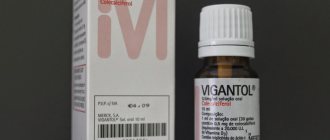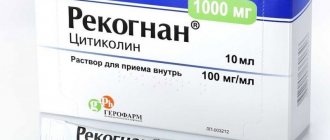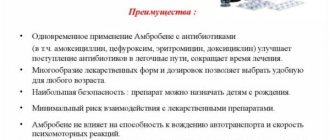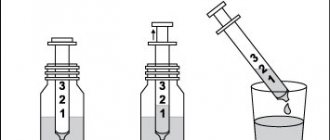Recognan solution for internal use 100 mg/ml 10 ml No. 10
Compound
Active substance: citicoline sodium - 10 g. Excipients: sorbitol - 20 g, glycerol - 5 g, methyl parahydroxybenzoate - 0.145 mg, propyl parahydroxybenzoate - 0.025 mg, potassium sorbate - 0.3 g, sodium citrate dihydrate - 0.6 g, sodium saccharinate - 0.02 g , strawberry flavor FRESA S.1487S - 0.04 g, citric acid - up to pH 6.0, purified water - up to 100 ml.
Pharmacokinetics
Suction
Citicoline is well absorbed when taken orally. Absorption after oral administration is almost complete, and bioavailability is approximately the same as after intravenous administration.
Metabolism
The drug is metabolized in the intestines and liver with the formation of choline and cytidine. After administration, the concentration of choline in the blood plasma increases significantly.
Distribution
Citicoline is widely distributed in brain structures, with rapid incorporation of choline fractions into structural phospholipids and cytidine fractions into cytidine nucleotides and nucleic acids. Citicoline penetrates the brain and is actively incorporated into cellular, cytoplasmic and mitochondrial membranes, forming part of the fraction of structural phospholipids.
Removal
Only 15% of the administered dose of citicoline is excreted from the human body: less than 3% by the kidneys and through the intestines and about 12% by exhaled air.
The excretion of citicoline in urine can be divided into 2 phases: a first phase, lasting about 36 hours, during which the rate of excretion decreases rapidly, and a second phase, during which the rate of excretion decreases much more slowly. The same is observed in exhaled air - the rate of elimination decreases rapidly after approximately 15 hours. And then it decreases much more slowly.
Indications for use
- ischemic stroke (acute period);
- ischemic and hemorrhagic stroke (recovery period);
- traumatic brain injury (acute and recovery period);
- cognitive impairment in degenerative and vascular diseases of the brain.
Contraindications
- vagotonia (predominance of the tone of the parasympathetic part of the autonomic nervous system);
- children and adolescents up to 18 years of age;
- hypersensitivity to citicoline.
Directions for use and doses
Recognan®, oral solution, is administered orally. Before use, the drug can be diluted in a small amount of water (120 ml or 1/2 cup).
Take with meals or between meals.
Recommended dosage regimen
- Acute period of ischemic stroke and traumatic brain injury (TBI):
1000 mg (10 ml or 1 sachet) every 12 hours. Duration of treatment for at least 6 weeks.
- Recovery period of ischemic and hemorrhagic strokes, recovery period of TBI, cognitive and behavioral disorders in degenerative and vascular diseases of the brain:
500-2000 mg per day (5-10 ml 1-2 times a day or 1 sachet (1000 mg) 1-2 times a day). Dosage and duration of treatment depending on the severity of the symptoms of the disease.
Elderly patients
When prescribing Recognan® to elderly patients, no dose adjustment is required.
Recommendations for the use of Recognan® in sachets:
1. Take the Recognan® 1000 mg sachet by the edge and shake.
2. Tear off the edge of the bag in the area indicated by the dotted line.
3. Drink the contents of the sachet immediately after opening.
4. Or dissolve in half a glass of drinking water (120 ml) and drink.
Storage conditions
Store out of the reach of children at a temperature of 15°C to 25°C.
Best before date
2 years. Do not use after the expiration date indicated on the package.
special instructions
Citicoline should not be used concomitantly with medicinal products containing meclofenoxate.
Description
Nootropic drug.
Dosage form
The solution for oral administration is clear, colorless, with a characteristic strawberry odor.
Use in children
Contraindicated in children and adolescents under 18 years of age.
Pharmacodynamics
Nootropic drug. Citicoline, being a precursor of key ultrastructural components of the cell membrane (mainly phospholipids), has a wide spectrum of action: it promotes the restoration of damaged cell membranes, inhibits the action of phospholipases, preventing the excessive formation of free radicals, and also prevents cell death by affecting the mechanisms of apoptosis.
In the acute period of stroke, it reduces the volume of damaged tissue and improves cholinergic transmission.
In case of traumatic brain injury, it reduces the duration of post-traumatic coma and the severity of neurological symptoms.
Citicoline improves the symptoms observed during hypoxia: memory impairment, emotional lability, lack of initiative, difficulties in performing daily activities and self-care. Effective in the treatment of cognitive, sensory and motor neurological disorders of degenerative and vascular etiology.
Side effects
From the nervous system: insomnia, headache, dizziness, agitation, tremor, numbness in paralyzed limbs.
From the digestive system: nausea, loss of appetite, changes in the activity of liver enzymes.
Allergic reactions: rash, itchy skin, anaphylactic shock.
Other: fever; in some cases - short-term hypotensive effect, stimulation of the parasympathetic nervous system.
Use during pregnancy and breastfeeding
There are no sufficient data on the use of citicoline in pregnant women. Although animal studies have not revealed any negative effects, during pregnancy the drug Recognan® is prescribed only in cases where the expected benefit to the mother outweighs the potential risk to the fetus.
When prescribing Recognan® during lactation, women should stop breastfeeding, since there is no data on the excretion of citicoline in human milk.
Interaction
Citicoline enhances the effects of levodopa.
Should not be administered concomitantly with medicinal products containing meclofenoxate.
Overdose
Given the low toxicity of the drug, cases of overdose have not been described.
Impact on the ability to drive vehicles and operate machinery
During the treatment period, care must be taken when performing potentially hazardous activities that require increased attention and speed of psychomotor reactions (driving a car and other vehicles, working with moving mechanisms, working as a dispatcher, operator, etc.).
Buy Recognan solution for internal use 100 mg/ml 10 ml No. 10 in pharmacies
MINISTRY OF HEALTH OF THE RUSSIAN FEDERATION
INSTRUCTIONS
ON THE APPLICATION OF THE MEDICINE FOR MEDICAL USE
RECOGNAN®
Read these instructions carefully before you start taking/using this medicine.
Save the instructions, you may need them again.
If you have any questions, consult your doctor.
This medicine is prescribed for you personally and should not be given to others because it may harm them even if they have the same symptoms as you.
Trade name: RECOGNAN®
International nonproprietary name: Citicoline
Dosage form: Oral solution
Compound
100 ml of the drug contains:
active ingredient: citicoline monosodium salt 10.45 g (equivalent to 10.00 g citicoline); excipients: sorbitol 20.0 g, glycerol 5.0 g, methyl parahydroxybenzoate 0.145 g, propyl parahydroxybenzoate 0.025 g, potassium sorbate 0.30 g, sodium citrate dihydrate 0.60 g, sodium saccharinate 0.02 g, strawberry flavor FRESA S. 1487S 0.04 g, citric acid to pH 6.0, purified water to 100 ml.
Description Transparent, colorless liquid with a characteristic strawberry odor.
Pharmacotherapeutic group:
nootropic agent
ATX code: N06BX06
Pharmacological properties
Pharmacodynamics
Citicoline, being a precursor of key ultrastructural components of the cell membrane (mainly phospholipids), has a wide spectrum of action - it promotes the restoration of damaged cell membranes, inhibits the action of phospholipases, preventing the excessive formation of free radicals, and also prevents cell death by affecting the mechanisms of apoptosis. In the acute period of stroke, it reduces the volume of brain tissue damage and improves cholinergic transmission. In case of traumatic brain injury, it reduces the duration of post-traumatic coma and the severity of neurological symptoms, in addition, it helps to reduce the duration of the recovery period.
Citicoline is effective in the treatment of cognitive, sensory and motor neurological disorders of degenerative and vascular etiology.
In chronic cerebral ischemia, citicoline is effective in treating disorders such as memory impairment, lack of initiative, and difficulties in performing daily activities and self-care. Increases the level of attention and consciousness, and also reduces the manifestation of amnesia.
Pharmacokinetics
Suction
Citicoline is well absorbed when taken orally. Absorption after oral administration is almost complete, and bioavailability is approximately the same as after intravenous administration.
Metabolism
The drug is metabolized in the intestines and liver with the formation of choline and cytidine. After administration, the concentration of choline in the blood plasma increases significantly.
Distribution
Citicoline is widely distributed in brain structures, with rapid incorporation of choline fractions into structural phospholipids and cytidine fractions into cytidine nucleotides and nucleic acids. Citicoline penetrates the brain and is actively incorporated into cellular, cytoplasmic and mitochondrial membranes, forming part of the fraction of structural phospholipids.
Removal
Only 15% of the administered dose of citicoline is excreted from the human body: less than 3% by the kidneys and through the intestines and about 12% by exhaled air.
The excretion of citicoline in urine can be divided into 2 phases: a first phase, lasting about 36 hours, during which the rate of excretion decreases rapidly, and a second phase, during which the rate of excretion decreases much more slowly. The same is observed in exhaled air - the rate of elimination decreases rapidly after approximately 15 hours. And then it decreases much more slowly.
Indications for use
Acute period of ischemic stroke (as part of complex therapy).
Recovery period of ischemic and hemorrhagic strokes.
Traumatic brain injury (TBI), acute (as part of complex therapy) and recovery period.
Cognitive and behavioral disorders in degenerative and vascular diseases of the brain.
Contraindications
It should not be prescribed to patients with severe vagotonia (predominance of the tone of the parasympathetic part of the autonomic nervous system) or with hypersensitivity to any of the components of the drug.
Rare hereditary diseases associated with fructose intolerance.
Due to the lack of sufficient clinical data, it is not recommended for use in children under 18 years of age.
Precautions for use
There is no information on relative contraindications when using the drug.
Use during pregnancy and breastfeeding There are no sufficient data on the use of citicoline in pregnant women.
Although animal studies have not revealed any negative effects, during pregnancy the drug Recognan® is prescribed only in cases where the expected benefit to the mother outweighs the potential risk to the fetus.
When prescribing Recognan® during lactation, women should stop breastfeeding, since there is no data on the excretion of citicoline in human milk.
Directions for use and doses
Recognan®, oral solution, is administered orally. Before use, the drug can be diluted in a small amount of water (120 ml or ½ glass).
Take with meals or between meals.
Recommended dosage regimen
Acute period of ischemic stroke and traumatic brain injury (TBI):
1000 mg (10 ml or 1 sachet) every 12 hours. Duration of treatment for at least 6 weeks.
Recovery period of ischemic and hemorrhagic strokes, recovery period of TBI, cognitive and behavioral disorders in degenerative and vascular diseases of the brain:
500-2000 mg per day (5-10 ml 1-2 times a day or 1 sachet (1000 mg) 1-2 times a day). Dosage and duration of treatment depending on the severity of the symptoms of the disease.
Elderly patients
When prescribing Recognan® to elderly patients, no dose adjustment is required.
Instructions for using the dosing pipette included with the bottle:
1. Place the dosing pipette into the bottle (the pipette plunger is completely lowered).
2. Carefully pull the plunger of the dosing pipette until the solution level is equal to the corresponding mark on the pipette.
3. Before taking, the required amount of solution can be diluted in 1/2 glass of water (120 ml).
After each use, it is recommended to rinse the dosing pipette with water.
Recommendations for the use of Recognan® in sachets:
Take the Recognan® 1000 mg sachet by the edge and shake.
Tear off the edge of the bag in the area indicated by the dotted line.
Drink the contents of the sachet immediately after opening.
Or dissolve in half a glass of drinking water (120 ml) and drink
Side effect Frequency of side effects
Very rare (< 1/10000) (including individual cases):
Allergic reactions (rash, skin itching, anaphylactic shock), headache, dizziness, feeling of heat, tremor, nausea, vomiting, diarrhea, hallucinations, swelling, shortness of breath, insomnia, agitation, loss of appetite, numbness in paralyzed limbs, changes in the activity of liver enzymes . In some cases, Recognan® may stimulate the parasympathetic system and also have a short-term effect on blood pressure levels.
If any of the side effects indicated in the instructions get worse, or any other side effects not listed in the instructions are noticed, you should report this to your doctor.
Overdose
Given the low toxicity of the drug, cases of overdose have not been described.
Interaction with other drugs
Citicoline enhances the effects of levodopa.
Should not be administered concomitantly with medicinal products containing meclofenoxate.
special instructions
In the cold, a small amount of crystals may form due to temporary partial crystallization of the preservative. With further storage under recommended conditions, the crystals dissolve within several months. The presence of crystals does not affect the quality of the drug.
Impact on the ability to drive vehicles and machinery
During the treatment period, care must be taken when performing potentially hazardous activities that require increased attention and speed of psychomotor reactions (driving a car and other vehicles, working with moving mechanisms, working as a dispatcher, operator, etc.).
Release form
Oral solution 100 mg/ml.
Bottle. 30 and 100 ml of the drug in bottles made of transparent glass III hydrolytic class, sealed with white screw caps made of polypropylene (PP) with an internal lining made of low-density polyethylene (LDPE) and tamper evident or white screw caps made of polyethylene (PE) with a sealing element made of polyethylene (PE) and tamper evident. A bottle with a dosing pipette and instructions for use are placed in a box made of cardboard.
Bags. 10 ml of the drug in bags made of multilayer combined material (polyethylene terephthalate - low density polyethylene - aluminum - polyethylene / PET - LDPE - AL - PE). Sachets in quantities of 5 or 10 pieces together with instructions for use are placed in a box of cardboard.
Storage conditions
Store at temperatures from 15 to 25 0C. Keep out of the reach of children.
Shelf life of the bottle is 3 years. Sachets – 2 years.
Do not use after the expiration date indicated on the package.
Vacation conditions
Available with prescription
Legal entity in whose name the registration certificate was issued
GEROPHARM LLC, Russia
Legal address: 191119, St. Petersburg, st. Zvenigorodskaya, 9
Hotline phone number: 8-800-333-4376 (calls within Russia are free)
Manufacturer
1) CJSC “Moscow Pharmaceutical Factory”, Russia (bottle);
2) SAG Manufacturing S.L.U., Spain (bag).
Manufacturer/place of production address
1) Russia, 125239, Moscow, Pharmaceutical proezd, 1 (bottle);
2) Spain, 28750, Madrid, Highway NI, 36 km, San Agustin de Guadalix (bag).
Organization receiving complaints
GEROPHARM LLC, Russia
191144, St. Petersburg, Degtyarny lane, 11, lit. B
Telephone (multi-channel), fax (812) 703-79-76
Hotline phone number: 8-800-333-4376 (calls within Russia are free)
www.geropharm.ru
CEO
LLC "GEROPHARM" P.P. Rodionov
Recognan solution for internal use 100 mg/ml pack 10 ml N 10
Active ingredient: citicoline
pharmachologic effect
Citicoline, being a precursor of key ultrastructural components of the cell membrane (mainly phospholipids), has a wide spectrum of action: it promotes the restoration of damaged cell membranes, inhibits the action of phospholipases, preventing the excessive formation of free radicals, and also preventing cell death by affecting the mechanisms of apoptosis.
In the acute period of stroke, it reduces the volume of damaged tissue and improves cholinergic transmission.
In case of traumatic brain injury, it reduces the duration of post-traumatic coma and the severity of neurological symptoms, in addition, it helps to reduce the duration of the recovery period.
Citicoline is effective in the treatment of cognitive, sensory and motor neurological disorders of degenerative and vascular etiology.
In chronic cerebral ischemia, citicoline is effective in treating disorders such as memory impairment, lack of initiative, and difficulties in performing daily activities and self-care. Increases the level of attention and consciousness, and also reduces the manifestation of amnesia.
Indications for the drug Recognan
- acute period of ischemic stroke (as part of complex therapy);
- recovery period of ischemic and hemorrhagic strokes;
- traumatic brain injury (TBI), acute (as part of complex therapy) and recovery period;
- cognitive and behavioral disorders in degenerative and vascular diseases of the brain.
Dosage regimen
Prescribed internally.
Take with meals or between meals. Before use, the drug can be diluted in a small amount of water (120 ml or 1/2 cup).
Acute period of ischemic stroke and TBI: 1000 mg (10 ml or 1 sachet) every 12 hours. Duration of treatment - at least 6 weeks.
Recovery period of ischemic and hemorrhagic strokes, recovery period of head injury, cognitive and behavioral disorders in degenerative and vascular diseases of the brain: 500-2000 mg/day (5-10 ml 1-2 times/day or 1 sachet 1-2 times/day ). The dose and duration of treatment are determined depending on the severity of the symptoms of the disease.
Elderly patients do not require dose adjustment.
Instructions for using the dosing pipette included with the bottle
1. Place the dosing pipette into the bottle (the pipette plunger is completely lowered).
2. Carefully pull the plunger of the dosing pipette until the solution level is equal to the corresponding mark on the pipette.
3. Before taking, the required amount of solution can be diluted in 1/2 glass of water (120 ml).
After each use, it is recommended to rinse the dosing pipette with water.
Recommendations for the use of Recognan in sachets
1. Take a sachet of Recognan 1000 mg by the edge and shake.
2. Tear off the edge of the bag in the place indicated by the dotted line.
3. Drink the contents of the sachet immediately after opening.
4. Or dissolve in 1/2 glass of drinking water (120 ml) and drink.
Before use, consultation with a specialist is required.
The method of administration and dosage regimen of a particular drug depend on its release form and other factors. The optimal dosage regimen is determined by the doctor.
Storage mode, interactions and side effects are indicated in the instructions.
Contraindications for use
- vagotonia (predominance of the tone of the parasympathetic part of the autonomic nervous system);
- rare hereditary diseases associated with fructose intolerance (for oral administration);
- children and adolescents under 18 years of age (due to lack of clinical data);
- hypersensitivity to the components of the drug.
Use during pregnancy and breastfeeding
There is insufficient data on the use of citicoline during pregnancy. Prescribing Recognan® is possible only in cases where the expected benefit of therapy for the mother outweighs the potential risk to the fetus.
Animal studies did not reveal any negative effects.
When prescribing Recognan® during lactation, women should stop breastfeeding, since there is no data on the excretion of citicoline in breast milk in humans.
Use in children
The use of the drug is contraindicated in children and adolescents under 18 years of age (due to the lack of clinical data).
Use in elderly patients
Elderly patients do not require dose adjustment.






